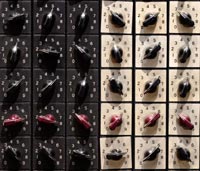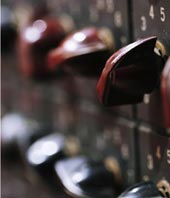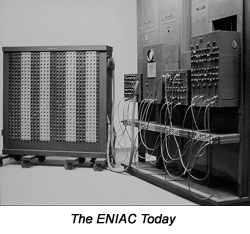


images © ENIAC Museum Online
ENIAC, 1946
33rd and Walnut Streets, Philadelphia PA 19104
Moore School of Electrical Engineering, University of Pennsylvania,
© Preston Thayer and Jed
Porter, Workshop of the World (Oliver Evans Press,
1990).
The Moore School was the
birthplace of ENIAC (Electronic Numerical Integrator and
Calculator), the world's first fully electronic,
general-purpose, digital computer. A mammoth affair that
operated on nearly 18,000 vacuum tubes, ENIAC was
developed by John Mauchly and J. Presper Eckert to speed
up ballistic calculations during World War II. Teams from
the Moore School and the U.S. Army Proving Grounds in
Aberdeen, Maryland, began working on the project in 1943,
and continued to work around the clock for the next 30
months. Despite their feverish efforts, ENIAC did not go
into operation until 1946—too late to help the war
effort. In 1947, the machine was transferred to Aberdeen
for use in the Army's Ballistic Research Labs. However,
sections of it are presently on display at the first
floor entrance of the Moore School off 33rd Street.
Update May
2007 (by
Harry Kyriakodis):
The Moore School displays four of ENIAC's forty panels,
representing approximately one-tenth of the machine's
original size. There are several panels at the
Smithsonian's National Museum of American History,
several more at the University of Michigan in Ann Arbor,
and a single panel at the Computer History Museum in
Mountain View, California. The U.S. Army Ordnance Museum
in Aberdeen, Maryland, also has some of ENIAC. Today, a
chip of silicon measuring 0.02 inches square holds the
same capacity as all of ENIAC.
See
also:
ENIAC Museum Online